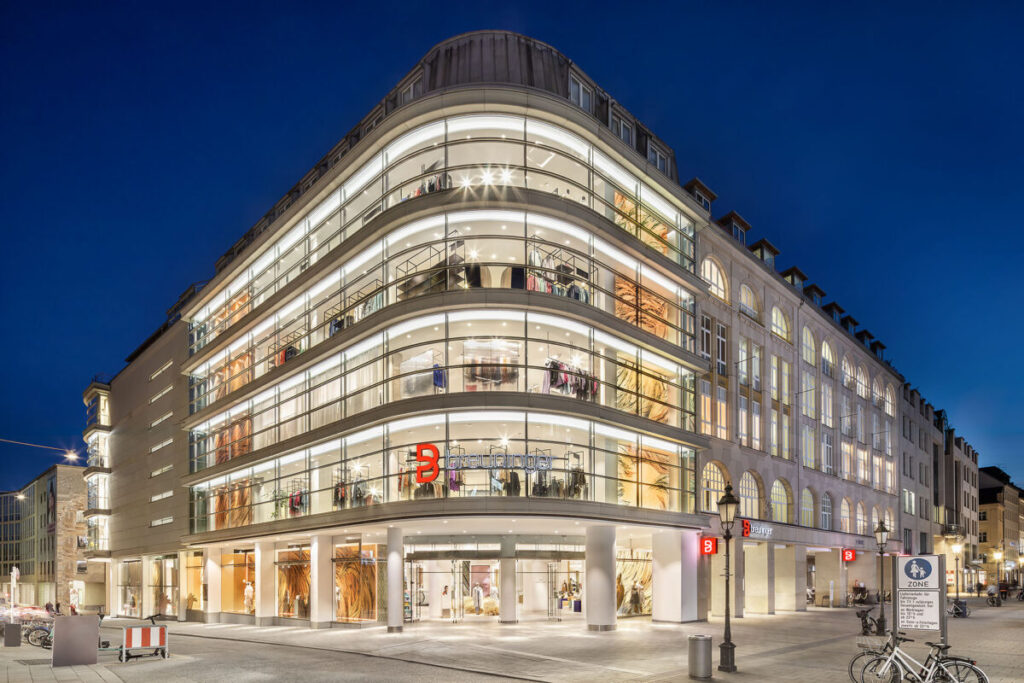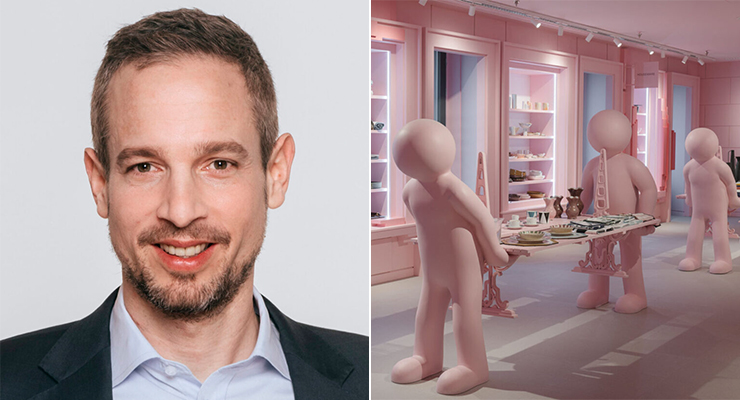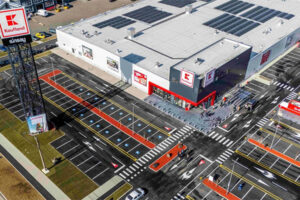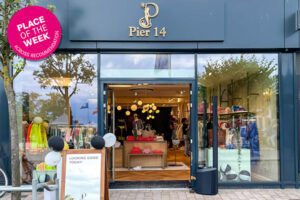ACROSS: CUSTOMER EXPECTATIONS OF RETAIL IN 2024 ARE THE SUBJECT OF CONTROVERSIAL DEBATE. ACCORDING TO A NUMBER OF REPORTS AND STUDIES, MODERN CONSUMERS ARE SATURATED AND ARE NO LONGER IN NEED OF ANYTHING BEYOND THEIR DAILY REQUIREMENTS. DO YOU SHARE THAT SENTIMENT?
JOHANNES BERENTZEN: No, our observations have been quite different. In fact, the opposite is true: Chinese platforms like Temu and Shein are not merely responding to existing demand; instead, they are generating entirely new demand by offering low-cost, non-essential products. The rapid growth of such platforms is proof of their consumer appeal. They advertise products that tend to fall into the gimmick category, in other words, products that are non-essential. That runs counter to all surveys on the issue of sustainability. At the other end of the scale, the luxury segment focuses on cultivating desire and exclusivity to drive demand. Nobody needs a watch that costs 10,000 euros only to know what time it is. However, customer expectations have become increasingly difficult to generalize. We observe marked differences between generations and income groups.
ACROSS: DESPITE ALL OF THAT, ARE THERE ANY FUNDAMENTAL SHIFTS IN CUSTOMER EXPECTATIONS?
BERENTZEN: One thing that is fundamentally true is the fact that demand has increasingly shifted to the online sector. The luxury sector is an exception in that regard; for many people, a trip to a brick and mortar store is an essential part of the luxury shopping experience. On the whole, it can also be said that Customers are far more informed than they were in the past. That is often due to the fact that they are able to prepare themselves for such purchases online. They are also more tech-savvy, and they certainly have higher expectations. They demand convenient and efficient shopping as well as personalized offers and customized service. The transaction costs for a purchase are key factors.
KEY TAKEAWAYS
– The costumers are well-informed and their expectations have increased
-The transaction costs of stationary retail are high, therefore the shopping experience must be outstanding
– Retailers need to demonstrate seamless omnichannel integration
– The attractiveness of a place and the happiness of costumers need to be reflected in the KPIs
– Elements that help to create the new KPI “Experience per square meter”: customer satisfaction, recommendation rate, length of stay, social media engagement, incentivized online sales, customer loyalty, the gross profit per square meter, conversion rate
ACROSS: WHAT DOES THAT MEAN?
BERENTZEN: When a consumer shops online, the purchase of a product is just a click away and, ideally, delivery is fast. The costs associated with such transactions are minimal. In brick-and-mortar retail, they are significantly higher. Consumers have to leave their homes, change clothes if necessary, and drive or use public transportation. Then, they have to find their way around the store or shopping center, wait in line, etc. They also run the risk of their goods not being available. In short: The transaction costs are high. As such, what should be offered to customers to compensate for these massive transaction costs? Their shopping experiences must be outstanding.
ACROSS: WHERE DO GENERATIONAL DIFFERENCES EXIST?
BERENTZEN: If we take a look at the groups in question, Generations X, Y, and Z, Generation X is characterized by keywords such as service and quality-oriented, price-conscious, traditional, and brick-and-mortar. I would attribute the following adjectives to Generation Y: convenient, flexible, tech-savvy, sustainable, and unique. I would characterize the “youngest” and increasingly affluent Gen Z target group as follows: interactive, visual, value-seeking, fast/instant, and digitally integrated. For Generation Z, in particular, the channel is completely irrelevant – it’s all about the shopping experience.
ACROSS: WHAT DOES THAT MEAN FOR RETAILERS, BRANDS, AND SHOPPING CENTERS?
BERENTZEN: Every player in the retail sector needs to place a much stronger focus on the customer – while that may sound like a truism, it is and will always remain at the core. Most companies operate heavily on the basis of key figures. However, customer happiness is not reflected in the turnover/rental figures. Of course, increased turnover indicates that more purchases have been made. However, a discount campaign can also artificially inflate those figures. Therefore, regular customer feedback and transparency regarding how the customer feels is essential. Touchscreens and surveys at shopping centers can be useful tools in that respect. Good cooperation between the tenant and the landlord is crucial when it comes to obtaining feedback. However, putting the customer at the center of everything also requires entrepreneurial courage.

ACROSS: IN WHAT WAY?
BERENTZEN: Simply put, it means questioning things that have always been done a certain way and finding fundamentally different approaches. In addition to entrepreneurial courage, such adjustments also require transparency, a willingness to innovate, and social responsibility. They also require seamless omnichannel integration, which, in my opinion, is an extremely important issue that is currently the weakest link in the chain. The German fashion retailer Breuninger, for example, does this incredibly well, while the vast majority of retailers do it particularly poorly.
ACROSS: IF A RETAILER DOES NOT HAVE AN OMNICHANNEL CONCEPT, WHAT ARE THE MEDIUM-TERM CONSEQUENCES?
BERENTZEN: If a retailer fails to implement seamless omnichannel integration, it risks losing connection not only with Generation Z but also with Generations X and Y. In the medium term, customers, regardless of which generation they belong to, will not understand why it works for some retailers but not for others. As a result, customers may take a look at great things at a shopping center but end up buying them online. What we want is the opposite: The customer should find inspiration online, then touch and experience the goods at a shopping center, and make their ultimate purchasing decision there, only that they may not wish to take the goods with them straight away because they have other things to do before going home. Seamless solutions are the order of the day. Admittedly, such solutions sound trivial, but all of the processes behind them are a masterstroke. And, that’s exactly the point: Retailers need to become more like online logistics providers, offer online payments, and adapt store spaces. That is a major process performance requirement, which is absolutely essential.
ACROSS: NEVERTHELESS, THERE ARE RETAILERS SUCH AS PRIMARK AND NEW YORKER THAT HAVE DELIBERATELY CHOSEN TO FOREGO THE USE OF E-COMMERCE.
BERENTZEN: Such examples exist, as well as retailers who still say that they have an online share of three to four percent. In the fashion market, where nearly 40 percent of goods are sold online and a large proportion of those goods are in the entry-level price segment, I would be particularly worried as an entry-level price provider. They simply cannot serve a large part of their own market. That might still work at present, but it won’t in the medium term. The fact is that providers such as Shein and Temu were not established to sell cheap products made in China in the long term. At the moment, their strategy is to gain as many app users as possible and generate awareness. They are not currently earning any money with that strategy and are simultaneously spending huge sums on advertising. Their long-term goal is to establish stable customer relationships. In the years to come, those providers will build up their own brands, improve their processes, invest in quality, and increase their prices. The customer will barely notice the price increase, as the difference compared to local providers will still remain the same. That’s why I think refusing to open up to the idea of an omnichannel approach is very risky.
ACROSS: YOU HAVE ALREADY MENTIONED THE SOUTHERN GERMAN FASHION RETAILER BREUNINGER AS A PRIME EXAMPLE. WHAT MAKES BREUNINGER BETTER THAN OTHERS?
BERENTZEN: First of all: Breuninger generates more than 50 percent of its 1.5 billion turnover online, while many others are struggling in the single-digit range. The company’s declared goal is to achieve online sales of over one billion euros. That’s a huge achievement for a fashion retailer that was regarded as a local medium-sized company in southern Germany just a few years ago. Today, Breuninger is a European omnichannel retailer. That is the direct result of early strategic orientation. Breuninger began collecting and using customer data at a very early stage. The company has used loyalty card systems for 65 years. It issued the first loyalty card with a payment function in 1959. It also consistently integrates all topics that are relevant online into its brick-and-mortar stores. It works with large service centers that allow customers to use Click & Collect, order in-store, order out-of-store, or return items purchased online at the store. Its online and multichannel affinity is particularly surprising as Breuninger operates in the premium segment, which, according to the unanimous opinion, does not lend itself to online business.
ACROSS: WHAT ARE THE FACTORS BEHIND WHY IT HAS WORKED REGARDLESS?
BERENTZEN: Sometimes, it’s the little things. Breuninger’s packages, for example, are lovingly prepared: They wrap the products in high-quality parchment paper and add a card or a message – all of which emotionalizes the moment of unpacking and stands in stark contrast to strong-smelling polyester clothing that is delivered in vacuum-sealed plastic bags. Staff and technology play key roles. An area of more than 5,000 square meters, which is dedicated to shoes, can be found in the basement of the new store in Munich. Not a single checkout counter is located there. Over 95 percent of payments are made via the app. Of course, that means that well-trained employees are on hand to process purchases via the digital customer account, similar to the Apple Store. The process has been well received by customers across all age groups – simply because it is easy and convenient.
ACROSS: DOESN’T THAT REDUCE THE SHARE OF ONLINE SALES?
BERENTZEN: No, Breuninger’s new location in Munich specifically highlights another advantage of a good omnichannel strategy. In Munich, the company was better known as an online retailer. One might have expected online sales to fall in the catchment area of the new store. However, the opposite is the case. Turnover has increased. That goes hand in hand with the results of studies that have looked at the entire European market and show that online sales significantly increase once brick-and-mortar stores are opened in the neighborhood. Identification with a brand grows when it can be experienced both digitally as well as at brick-and-mortar stores.
ACROSS: HOWEVER, SUCCESSFUL IMPLEMENTATION REQUIRES FINANCIAL RESOURCES AND TIME – BOTH OF WHICH ARE IN SHORT SUPPLY IN TODAY’S RETAIL WORLD.
BERENTZEN: Absolutely. It takes time and substantial investment in technology and personnel. That will make it difficult for some providers to catch up. After all, they have to operate on an equal footing with pure online providers, such as Amazon and Zalando.
ACROSS: SHOPPING EXPERIENCE IS THE BIG BUZZ WORD IN BRICK-AND-MORTAR RETAIL. WHAT IS YOUR DEFINITION OF THE TERM?
BERENTZEN: In the retail context, it means creating a memorable, emotionally appealing, and interactive shopping experience that goes beyond the pure product offer, thereby inspiring and retaining the customer. When linking channels, that means consistent brand presence, digital integration, an omnichannel strategy, and continuous performance measurement.
ACROSS: HOW CAN EXPERIENCE BE MEASURED?
BERENTZEN: “Experience per square meter” cannot be measured as a single key figure. However, the causal influencing factors, so-called formative constructs, and the positive effects of a better experience, so-called reflexive constructs, can be placed in an overall context. That’s referred to as a causal model. In other words, it’s about cause and effect. Causal factors include, for example, atmosphere and multi-sensory technology, event and participatory offers, interactive and playful elements, staff, the staging and curation of goods, online integration, and community building. Those are all small things that I can do to improve a subjectively perceived shopping experience. What has to be measured, however, are other elements.
ACROSS: CAN YOU NAME SOME EXAMPLES?
BERENTZEN: The first thing is customer satisfaction, both global satisfaction and individual satisfaction. Next comes the traditional recommendation rate. The length of stay is another indicator. The longer I stay somewhere, the more comfortable I feel, the more I buy, and, perhaps, the better my experience. Social media engagement is also important: How big is the response to brick and mortar events, for example. In my opinion, incentivized online sales are essential. If I have a good experience, I may not necessarily buy locally, but perhaps online at some point later at the same store, which can also be seen as an indicator that the experience was good. Customer loyalty is another key figure. That includes, for example, how often I return to the store or how often I take part in events. The statistics resulting from customer card usage are very important in this regard. Other tracking options include feedback on service usage and complaint management. If you look at gross profit per square meter instead of sales per square meter, you also get a better indication of the quality of sales. That is due to the fact that customers may be more likely to buy the more expensive product in an atmosphere of well-being and experience. The conversion rate is another aspect. The weighting given to each factor is key. Exciting models can be created on that basis.
ACROSS: ANYONE WHO, LIKE BREUNINGER, DOES A GOOD JOB OF IMPLEMENTING ALL OF THIS WILL MEASURE ALL OF THESE THINGS – EVEN WITHOUT A MODEL.
BERENTZEN: Of course, no one has begun to work with an “experience per square meter” metric yet, even though it would make perfect sense. In my opinion, retailers would greatly benefit from an experience parameter index. The reference to space is important in this context, because experience always involves using space that would otherwise be filled with goods in a different way. Anyone who achieves success by creating positive experiences will actively address and measure many of the influencing factors mentioned. Ultimately, such companies do nothing other than apply this construct without calculating the abstract “experience per square meter” figure.
ACROSS: DOES EXPERIENCE PER SQUARE METER EQUATE TO RELEVANCE FOR THE CUSTOMER?
BERENTZEN: No, that would be too short-sighted. Relevance is a rather abstract but small part of it. An ugly little supermarket next door can be extremely relevant, but it certainly doesn’t offer any kind of experience.
ACROSS: WHAT DOES THIS MEAN FOR TRADITIONAL KEY FIGURES SUCH AS TURNOVER?
BERENTZEN: Let’s start with the most traditional one: sales per square meter. That figure is no longer suitable as the sole indicator due to the many new roles that retail space plays. At the very least, additional turnover from online incentives, retail media income, and services should be added. Moreover, additional sales are often “purchased” as part of discount campaigns. In the end, however, it’s all about yield.

ACROSS: THAT MAKES THINGS EVEN MORE COMPLICATED FOR STORES THAT NO LONGER SELL IN THE TRADITIONAL MANNER.
BERENTZEN: The WOW concept in Madrid is one such example. There are no traditional sales there. Customers make purchases online using a scanned QR code. The turnover per square meter is zero every day. Adjustments regarding the extended definition of turnover are not trivial. While retailers are reluctant to become transparent, they may often not even have such transparency themselves. The amount of incentivized online sales can never be precisely quantified. However: Significant adjustments need to be made to traditional shopping center lease agreements.
ACROSS: HOW DO YOU COMMUNICATE SUCH AN APPROACH TO “TRADITIONAL” RETAILERS AND SHOPPING CENTER MANAGEMENT TEAMS?
BERENTZEN: For both retailers and shopping centers, the best possible shopping experience is essential for survival. There is no need for persuasion in that respect. However, improving the individual influencing factors is often expensive, especially when multiple steps are required at once, and this is uncharted entrepreneurial territory for many. That’s why we provide consulting services to retailers and shopping centers to support them with their strategic and conceptual requirements and, in some cases, also assist with implementation.
ACROSS: HOW CAN SUCCESS BE MEASURED IN TERMS OF IMPLEMENTATION? WHAT OPPORTUNITIES DOES TECHNOLOGY, IN PARTICULAR, OFFER?
BERENTZEN: What is technologically possible in brick-and-mortar retail today can compensate, to a certain extent, for the information advantage that online providers have. Online, every click, every mouse movement can be measured 100 percent, and companies invest a lot of money in analyzing such data. Every day, websites change countless times in order to address customers individually and optimally. Technology has enabled us to collect customer data on the shop floor as well. For example, we can measure movements and length of stay in a shop to an accuracy of 30 cm. Such data provides us with more in-depth understanding of our customers and helps us to continuously measure and improve the shopping experience. Technology helps with marketing in the same way. Any retailer can create a social media campaign with just a few clicks and prompts using artificial intelligence. It’s not groundbreaking, but it provides a 70 percent solution in five percent of the time at one percent of the cost.
ACROSS: HOW CAN RETAILERS USE THE KNOWLEDGE GAINED TO OPTIMIZE STORE LAYOUTS AND EXPERIENCE OFFERS?
BERENTZEN: The credo is “inspect and adapt”, in other words, measure and adjust on a regular basis. What is perceived as a unique experience today may seem boring and redundant tomorrow.
ACROSS: WE HAVE ALREADY TOUCHED ON THE SUBJECT OF GOOD STAGING. THAT REQUIRES COURAGE, CREATIVITY, AND GOOD PERSONNEL. WHAT ELSE?
BERENTZEN: Of course, good staging is in the eye of the beholder. In general, the atmosphere, store design, and product presentation should be consistent and supported by good staff. A catch phrase in this context is “shopping with all of your senses”. The advantage of brick-and-mortar retail over online retail, which is here to stay, is that customers can see, hear, taste, feel, and smell products in-store. Many of today’s concepts rely on elaborate sound installations and strong visual stimuli. In numerous categories, such as furniture, fashion, and sport, touch is a key selling point for brick-and-mortar shopping. Smell and taste are also addressed through the integration of gastronomy and hospitality offers. One of the most well-known examples of smell could be found at Abercrombie, where you could smell their signature perfume long before entering the store. A great deal is possible when it comes to smell. Shopping centers can develop their own smell zones within their food courts, depending on what is on offer in the area.
ACROSS: INITIALLY, STIMULI SOUND POSITIVE, BUT WHAT ARE THE LIMITS IN TERMS OF STAGING AND WHEN DOES OVERLOAD BEGIN?
BERENTZEN: Overload occurs when there are too many visual stimuli, the layout is chaotic or overwhelming, or when unclear messages are sent, for example when too many themes are presented. Digital overload can also occur if there are too many displays and interactive screens or if navigation is too complicated. Similarly, music that is too loud or inappropriate can lead to acoustic overload. This is why a number of retailers deliberately refrain from playing any kind of music.
ACROSS: IN CONCLUSION: WHAT ARE THE KEY ADJUSTMENTS THAT RETAILERS AND SHOPPING CENTERS NEED TO MAKE WHEN IT COMES TO EXPERIENCE-DRIVEN RETAIL?
BERENTZEN: Customer perspective is always the most important thing. How can we ensure that customers continue to shop at brick and-mortar stores despite significantly higher transaction costs? A new understanding of the role played by brick-and-mortar stores and the factors that influence a better customer experience will help in that regard. Last but not least, we need to look at the wider context of the retail space in question, in other words, the role of the shopping center, retail park, or city center. Good cooperation between retailers, landlords or owners, and the authorities is crucial for successful implementation.

Dr. Johannes Berentzen
Dr. Johannes Berentzen is the Managing Director of retail consultancy BBE.







